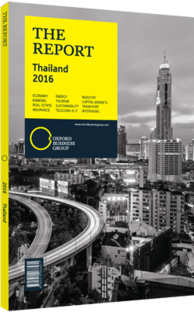Water conservation efforts in Thailand's agriculture sector
In spite of all the technological gains agriculture has made over the years, crop output from season to season still ultimately depends upon the forces of nature. The often dramatic production fluctuations witnessed every year around the globe are most often the result of favourable or inclement weather patterns rather than any man-made or controllable factor. For Thailand, a successful harvest is heavily dependent upon favourable levels of precipitation during the rainy season. Over the past two years abnormally dry conditions have severely affected crop seasons, forcing the government to scramble to address the issue.
Dry Spell
As of late 2015 Thailand was in the midst of a second consecutive year of below-normal rainfall, placing severe stress on the agricultural sector and slowing overall economic growth. Cumulative annual rainfall throughout October 2015 was 16% below average, according to the Meteorological Department. With the bulk of the country’s irrigated farmland and urban population reliant on water accumulated in highland reservoirs, the recent rainfall deficit in the north western watersheds resulted in insufficient reservoir recharge and a significant depletion in the national water supply. As of October 2015, available water resources were 35% lower than at the same time in 2014 and 64% lower than the 10-year average.
Man-Made Solutions
In an effort to mitigate the negative effects of these events and mindful of increasingly erratic weather conditions accelerated by global climate change and cyclical patterns such as El Niño, the agriculture industry is turning increasingly to modern advances such as hybrid and genetically modified organisms, irrigation, farm mechanisation, fertilisation and other techniques to reduce the effects of unpredictable weather. In September 2015 the Ministry of Agriculture and Cooperatives (MAC) proposed new measures to assist drought-stricken farmers, including extensions of debt repayment for farmers to the state-owned Bank for Agriculture and Agricultural Cooperatives (BAAC); new job creation for farmers; community drought relief programmes; boosting water efficiency measures and increasing water resources through increased dredging; artificial rain-making; and further development of underground reservoirs. These plans coincided with press reports in July 2015 announcing the approval by the Ministry of Finance of up to BT60bn ($1.8bn) in loans for farmers. Issued by BAAC, with repayment periods from one to 10 years, the loans vary in type, ranging from short-term funds for emergencies related to drought rehabilitation to long-term assistance to increase farm productivity. Another longer-term solution rolled out by the government is a mandate issued by the MAC in September 2015 for the RID to investigate new water sources in an effort to boost the supplies for the fiscal year 2016.
Short-Term Response
While many of these measures are, in the main, part of a medium- to long-term strategy, the government has also been forced to enact more drastic short-term emergency measures to deal with the current crisis. In late 2015 the RID issued a ban on off-season rice cultivation in response to limited water supplies, prioritising limited water resources for household consumption. The RID has taken a strong stance on the issue since September 2015, declaring that no irrigation stations be authorised to supply water for the off-season rice crop, although full enforcement of the policy could prove daunting, with many farmers likely to challenge any restrictions which would substantially curtail annual production and income. In a typical year, Thai farmers would cultivate approximately 2m ha of rice in the dry season, producing, on average, 5.6m tonnes of rice.
You have reached the limit of premium articles you can view for free.
Choose from the options below to purchase print or digital editions of our Reports. You can also purchase a website subscription giving you unlimited access to all of our Reports online for 12 months.
If you have already purchased this Report or have a website subscription, please login to continue.

